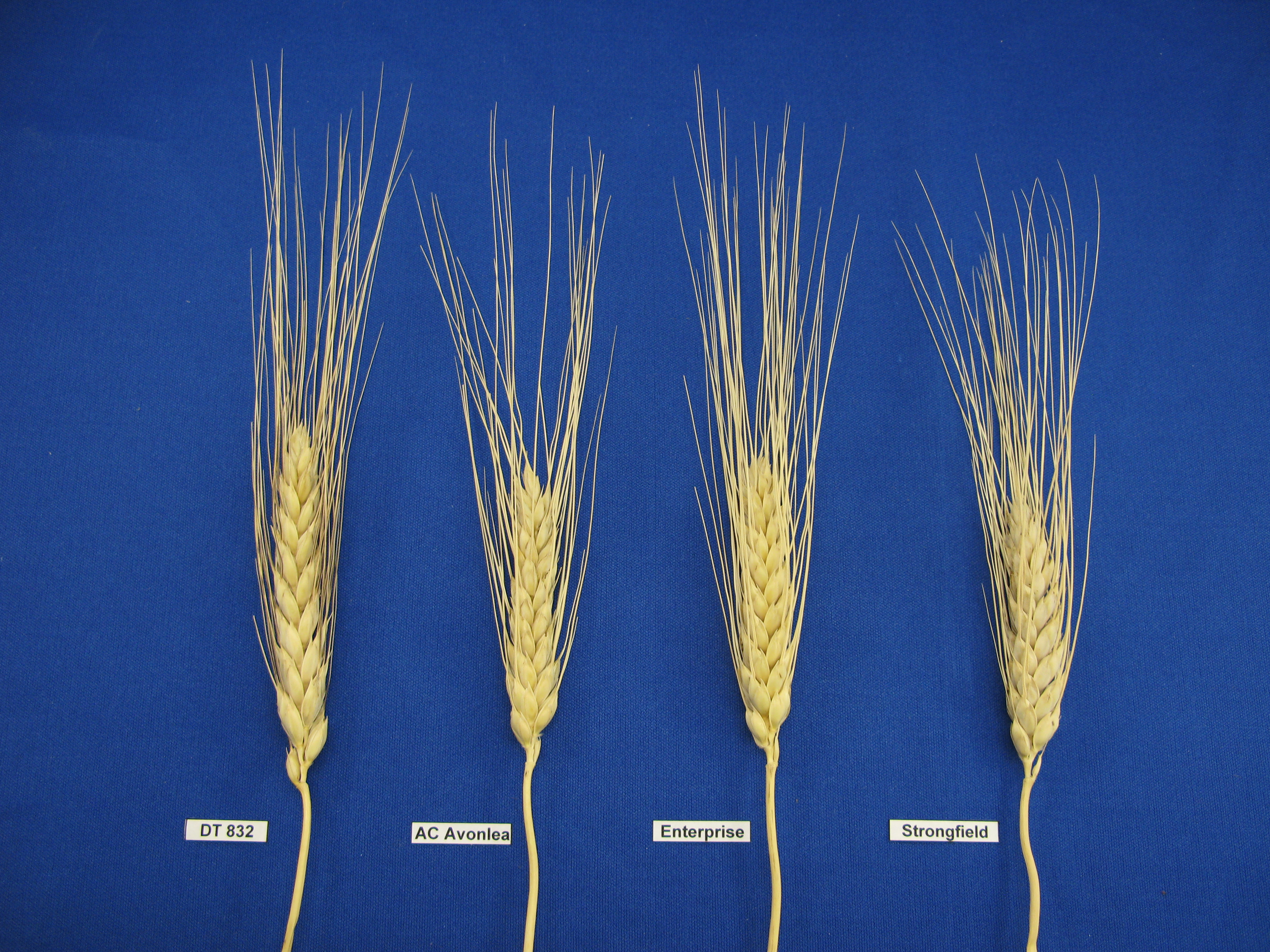AAC Durafield
| Denomination: | 'AAC Durafield' |
|---|---|
| Botanical Name: | Triticum turgidum subsp. durum |
| Applicant/Holder: |
Agriculture & Agri-Food Canada, Swift Current Research and Development Centre 1 Airport Road P.O. Box 1030 Swift Current, Saskatchewan S9H 3X2 Canada |
| Breeder: |
Asheesh K. Singh, Agriculture & Agri-Food Canada, Swift Current, Saskatchewan |
| Agent in Canada: |
Agriculture & Agri-Food Canada Office of Intellectual Property and Commercialization c/o Shannon Whyte 107 Science Place Saskatoon, Saskatchewan S7N 0X2 Canada Tel: (204) 999-9887 |
| Application Date: | 2013-04-19 |
| Application Number: | 13-8013 |
| Grant of Rights Date: | 2015-09-10 |
| Certificate Number: | 5106 |
| Date rights surrendered: | 2019-05-28 |
Variety Description
Varieties used for comparison: 'AC Avonlea', 'Enterprise' and 'Strongfield'
Summary: The flag leaves of 'AAC Durafield' are shorter than those of 'Enterprise' and 'Strongfield'. 'AAC Durafield' is later heading than 'AC Avonlea'. The spike of 'AAC Durafield' is shorter than that of 'AC Avonlea' and longer than that of 'Enterprise' and 'Strongfield'. The lower glume of 'AAC Durafield' is shorter than that of 'AC Avonlea'.
Description:
PLANT: spring type, intermediate growth habit at the 5 to 9 tiller stage, late heading, matures mid to late season
SEEDLING: strong to very strong intensity of anthocyanin colouration of coleoptile, glabrous lower leaf sheaths and blades
FLAG LEAF: high frequency of plants with recurved/drooping flag leaves, very weak anthocyanin colouration of auricles, ranges from medium to strong to very strong glaucosity of sheath, glabrous blade and sheath
CULM NECK: medium to strong glaucosity, slightly curved
STRAW: thin to medium thickness of pith in cross section, no anthocyanin colouration at maturity
SPIKE: strong glaucosity, tapering to parallel-sided shape in profile, dense, off-white to yellow at maturity, erect attitude at maturity, sparse hairiness of convex surface of apical segment
AWNS: longer than length of spike, black to grey but can be off-white when grown under dry conditions
LOWER GLUME: medium to long, medium width, glabrous
LOWER GLUME SHOULDER: narrow to medium width, elevated to sloping shape
LOWER GLUME BEAK: slightly to moderately curved
LOWEST LEMMA: straight to moderately curved
KERNEL: amber colour, large, elliptical shape, angular cheek, short brush hairs, medium to wide width and medium to deep depth of crease
GERM: large, oval shape
RESISTANCE TO SHATTERING: good
PASTA QUALITY: good
DISEASE REACTIONS: resistant to Leaf Rust (Puccinia recondita), Stem Rust (Puccinia graminis f. sp. tritici) and Common Bunt (Tilletia caries, Tilletia foetida) and susceptible to Loose smut (Ustilago tritici) and Fusarium head blight (Fusarium graminearum, Fusarium species)
Origin & Breeding History: 'AAC Durafield' (tested as DT832) was derived from the cross DT749 / DT735 // 'Strongfield' made in 2003 at the Semiarid Prairie Agricultural Research Centre, Swift Current, Saskatchewan. It was developed using a doubled haploid technique using the wheat-maize pollen system. In 2005, 190 doubled haploid genotypes from the population were grown near Swift Current and 276 genotypes were grown near Leeston, New Zealand, during the winter of 2005-2006. Selections were made based on disease resistance, plant height and straw strength. Of these, 137 genotypes were selected and harvested as seed source for agronomic trials in Canada. In 2006, 182 doubled haploid genotypes were grown near Swift Current and Regina, Saskatchewan, and Lethbridge, Alberta. Eleven doubled haploid genotypes, including A0345&BV022, were selected for agronomic performance, disease resistance and end-use quality and tested in the 2007 Durum Western A2 test grown at four locations in western Canada. Various disease reactions were assessed at various locations throughout the Prairie provinces. A0345&BV022 was tested in the Durum B test in 2008, and evaluated in the Durum cooperative tests as DT832 from 2009 to 2012.
Tests & Trials: Tests and trials were conducted at the Semiarid Prairie Agricultural Research Centre, Swift Current, Saskatchewan in 2012 and 2013. Plots consisted of 4 rows, each 3 metres long with inter-row spacing of 23 cm with 4 replications per variety arranged in an RCB design. There were 40 leaf and 20 spike measurements. Means are based on a two year average. Differences are significant at the 5% probability level based on LSD values. Disease ratings were provided through the Disease Evaluation team of the Prairie Recommending Committee for Wheat, Rye and Triticale, Prairie Grain Development Committee.
Comparison tables for 'AAC Durafield' with reference varieties 'AC Avonlea', 'Enterprise' and 'Strongfield'
Flag leaf length (cm)
| 'AAC Durafield' | 'AC Avonlea' | 'Enterprise' | 'Strongfield' | |
|---|---|---|---|---|
| mean (LSD=2.1) | 24.7 | 26.4 | 27.0 | 27.5 |
| std. deviation | 2.2 | 3.8 | 3.4 | 3.4 |
Days to heading (50% of heads fully emerged from boot)
| 'AAC Durafield' | 'AC Avonlea' | 'Enterprise' | 'Strongfield' | |
|---|---|---|---|---|
| mean (LSD=1.3) | 59.0 | 57.1 | 58.9 | 58.4 |
Spike length (excluding awns) (cm)
| 'AAC Durafield' | 'AC Avonlea' | 'Enterprise' | 'Strongfield' | |
|---|---|---|---|---|
| mean (LSD=0.30) | 7.9 | 8.3 | 7.6 | 7.4 |
| std. deviation | 0.5 | 0.5 | 0.5 | 0.4 |
Glume length (mm)
| 'AAC Durafield' | 'AC Avonlea' | 'Enterprise' | 'Strongfield' | |
|---|---|---|---|---|
| mean (LSD=0.34) | 8.8 | 9.5 | 8.9 | 8.9 |
Click on image for larger view

Wheat: 'AAC Durafield' (left) with reference varieties 'AC Avonlea' (centre left), 'Enterprise' (centre right) and 'Strongfield' (right)
- Date modified: